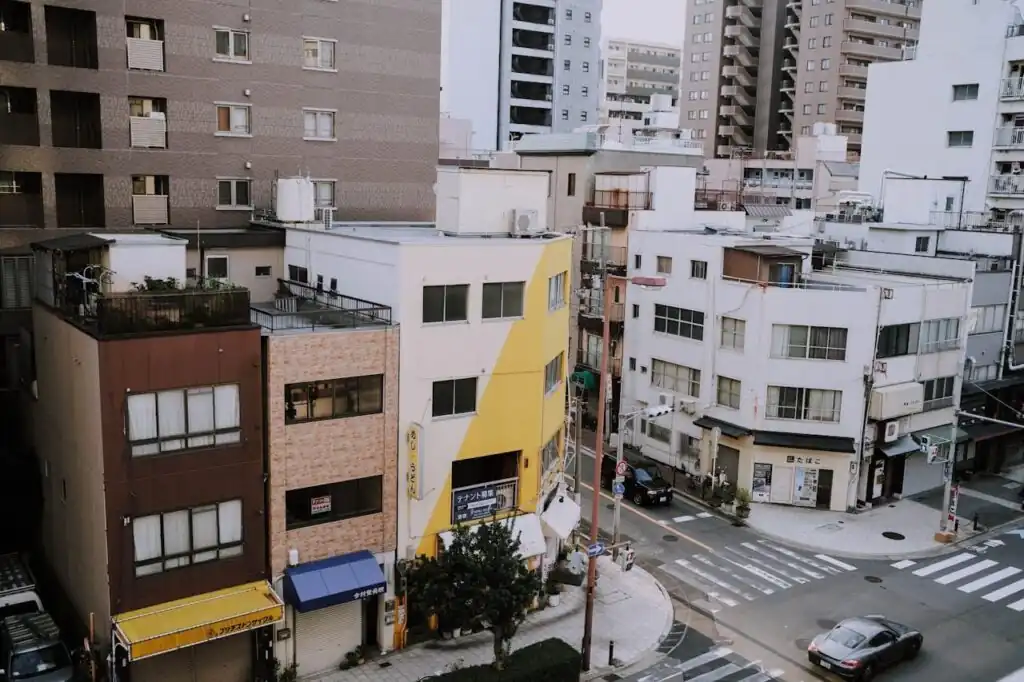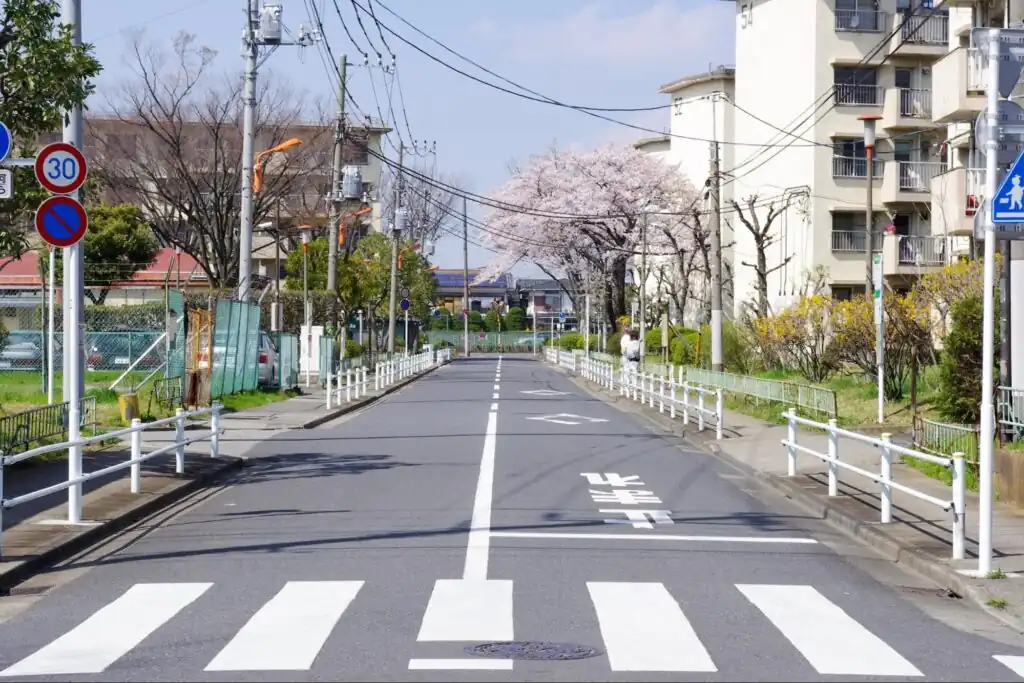A survey of 180 men and women in the greater Tokyo area, aged 20 and above, conducted in 2019 revealed that 31.1% of them considered a 10-minute walk “close to the station”. Another 25% said that a 5-minute walk was considered “near the station”, whilst 10% said that a 16-minute walk was “within walking distance to the nearest train station”.
In general, respondents of the survey lived an average of 13.6 minutes’ walk away from their nearest train station, and depending on where you live in Japan, the difference in rent can be anywhere from ¥10,000 to ¥20,000 between a rental property 5 minutes’ walk away from the station and 10 minutes.
Many Japanese real estate agencies state that the average walking rate per minute is 80 meters or 262.5 feet on flat terrain. However, this distance can vary depending on other external factors including type of road, neighborhood, and weather conditions.
If you’re considering a rental property further away from the train station, some things to take into consideration include:
- Total commute time (walk from the apartment or house to the train station + time on the train)
- Are you moving as a single individual, with a partner, or with a family?
- Budget
- Availability of bicycles and cars in your possession
- Bicycle and car parking fees
- Working lifestyle – do you work from home, in the office, or a combination of both?
Other factors to take into account when considering a rental property further away from the train station will be discussed below.
Available Rental Properties

The number of rental properties available tends to increase the farther away from a train station you go. They also tend to be bigger but cheaper, and both the real estate agent and landlord may be more open and amenable to negotiations on things such as initial move-in costs and rent.
If you work from home or have a hybrid schedule and only have to commute to the office a few times a week, then such properties may be an attractive option as you can dedicate one room to a study or office space.
If you’re moving with a partner or family, they’ll benefit from a bigger apartment or house as everyone will be able to have their own dedicated space.
Real estate agencies such as Village House have listings that show how far the rental property is from the nearest train station. Talk with one of their representatives if you’re interested in these types of rental properties.
Quiet Neighborhoods

Another benefit of living further away from a train station is that there’ll be less noise and light pollution from both the trains and the shops surrounding the area. This makes such properties particularly attractive to those with families who may prefer a quieter neighborhood to ensure their children’s bedtime and sleep routines aren’t disturbed.
The obvious disadvantage to this is that being away from the hustle and bustle means being away from the accessibility and convenience of having shops, services, and amenities a stone’s throw away. It might make grocery shopping and spontaneous buys a bit more tricky as such activities will have to be pre-planned and scheduled.
Getting Around by Bicycle

Taking into consideration that Japan is a four-season country that brings hot and humid summers, a month-long rainy season, and an annual typhoon season, walking 20 minutes to the train station can become a very unattractive option in such weather conditions.
A logical solution to this is to invest in a bicycle, which for numerous Japanese citizens and residents, is one of their main forms of transport when going to work or school.
The obvious advantage is that it cuts down your commute time from your home to the train station and you get in some exercise while doing so!
The disadvantage of owning a bicycle in Japan is that it needs to be registered, which can be a hassle as different prefectures have different procedures on how one can register and unregister their bicycle.
Owning a bicycle also means that you’ll need to park it somewhere before you head to the train station as it’s quite uncommon for commuters to bring their bicycles onto public transport in Japan, and there are strict rules one must abide by if you wish to do. This means that you’ll have to factor in daily, weekly, or monthly bicycle parking fees, which can eat into your overall monthly budget.
If you have a family, then you might have to invest in a bicycle for each family member and this may lead to a storage issue of where to put them. Luckily, many Japanese apartment buildings come with a dedicated bicycle storage area for their tenants so this may not be that big of an issue but to ensure that the rental property you’re interested in has such amenities, check and confirm with your real estate agent or landlord before signing a lease.
Using the Bus or a Car: Avoid a Lack of Exercise

Some may not want to cycle to the train station and opt to take a bus instead. While this cuts down your commute time to the train station, it also deprives you of the exercise gained from biking to and from the train station.
If you own a car, choosing a property that is 20 minutes away from the train station may be a no-brainer as you may opt to drive to work or the train station instead. The drawback of this is that you’ll need to find a parking spot for your car, both permanent for when you’re home, and temporary for when you leave it before hopping on the train. As land is limited in Japan, finding a parking spot is both difficult, time-consuming, and pricey; so, if you’re on a tight budget, moving into such properties may not be the best option for you.
Since many of Village House’s locations that lie outside of the major cities are located in car-centric areas, Village House properties offer parking spaces at affordable prices. It is even possible to opt for extra parking for those owning more than one car. If you’re interested, please consider checking out Village House’s available apartments.
Wasting Time for Longer Commuting Times

Possibly the biggest disadvantage of living a 20-minute walk from the train station is the amount of time you’re going to end up wasting, even if you bike, drive, or take the bus. Whatever method you choose to transport yourself to the train station, you’re still going to have to wake up early to make the train that’ll get you to work or school on time, and for those who are not naturally early risers, this can pose a serious problem (people who work from home need not apply).
If you walk, cycle, or drive to the station, you have more control over your time as you do not have to abide by a schedule but for those who opt to take a bus to the station, you’ll have to ensure that you get to the bus station on time. Missing it can derail your schedule and make you late, especially if the bus doesn’t come at quick and frequent intervals.
In sum, living farther away from the train station may be beneficial for those who work from home, own a bicycle or car, or don’t mind waking earlier to compensate for the longer distance. However, for those who may have a propensity to rush in the mornings or already have a long commute by train, living more than a 10-minute away from the nearest train station may not be suitable or feasible in the long run.
If you need or want to move, consider checking out Village House, a real estate organization with over 1,000 rental properties across Japan’s 47 prefectures.
Related articles:
- Does it Make Sense to Move Somewhere Far From Your Work? Pros and Cons of a Long Commute
- Rental Apartment Woes? Here’s Where to Get Expert Advice!
- Should You Rent a South-Facing Apartment? All the Pros and Cons!

Freelance writer with over 2 years of experience writing for the Village House Blog, ESL teacher, and digital nomad who has lived in countries including The Czech Republic, The UK, The U.A.E., Japan, and most recently, Georgia. Is constantly on the hunt for the best, most optimal apartment for remote work when not enjoying going to film festivals, concerts, and the theater.



